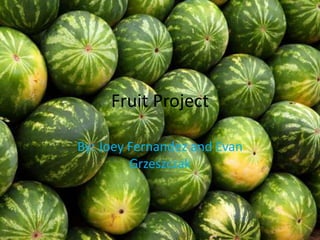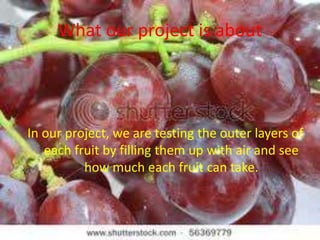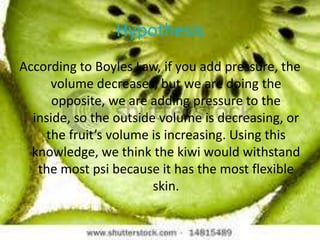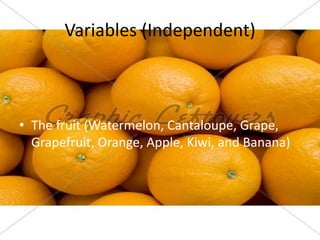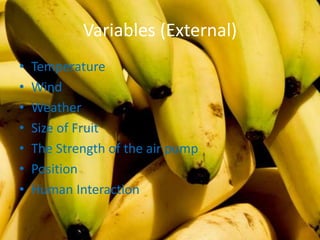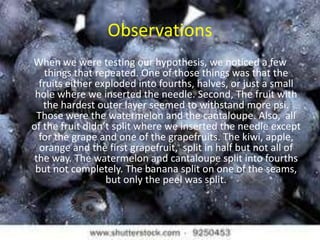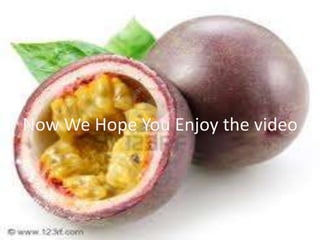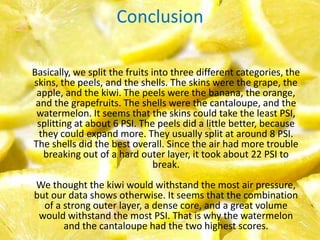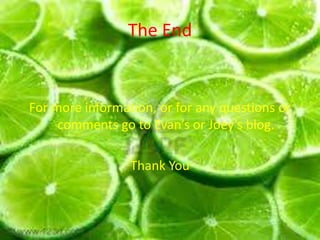Fruit project powerpoint
- 1. Fruit ProjectBy: Joey Fernandez and Evan Grzeszczak
- 2. What our project is aboutIn our project, we are testing the outer layers of each fruit by filling them up with air and see how much each fruit can take.
- 3. HypothesisAccording to Boyles Law, if you add pressure, the volume decreases, but we are doing the opposite, we are adding pressure to the inside, so the outside volume is decreasing, or the fruit’s volume is increasing. Using this knowledge, we think the kiwi would withstand the most psi because it has the most flexible skin.
- 5. Grape
- 6. Kiwi
- 7. Towel
- 8. Video Camera
- 9. ClementineAir PumpAir Pump NeedleAir Pump GaugeWatermelonCantaloupeAppleBanana
- 10. Variables (Constant)Where we tested the fruitsHow we tested themHow we added the airHow we measured the psi
- 11. Variables (Independent)The fruit (Watermelon, Cantaloupe, Grape, Grapefruit, Orange, Apple, Kiwi, and Banana)
- 12. Variables (External)TemperatureWindWeatherSize of FruitThe Strength of the air pumpPositionHuman Interaction
- 13. ProcedureTo test our hypothesis, Joey bought the fruit while Evan got the air pump and nozzle. After we had gathered all of our materials, we set up our testing spot in Evan’s Ěýgarage thus taking out the external variables wind, weather, and temperature. Then we laid down an old towel to make clean up easier. Next we loaded up the air pump to 100 psi. Evan’s dad attached the nozzle to the air pump. We laid down the first fruit on its side. Joey watched the air pump gauge, Evan’s dad video taped, and Evan inserted the needle into the side of the fruit. Joey and Evan switched jobs for every fruit. At the breaking point of the fruit, Joey or Evan looked at the gauge and recorded how far the needle on the gauge moved. After repeating the process for every fruit, we put our data into graphs. While looking at the graphs, we analyzed our data and found our conclusion.
- 14. ObservationsWhen we were testing our hypothesis, we noticed a few things that repeated. One of those things was that the fruits either exploded into fourths, halves, or just a small hole where we inserted the needle. Second, The fruit with the hardest outer layer seemed to withstand more psi. Those were the watermelon and the cantaloupe. Also, Ěýall of the fruit didn’t split where we inserted the needle except for the grape and one of the grapefruits. The kiwi, apple, orange and the first grapefruit, Ěýsplit in half but not all of the way. The watermelon and cantaloupe split into fourths but not completely. The banana split on one of the seams, but only the peel was split.
- 15. Now We Hope You Enjoy the video
- 16. ConclusionBasically, we split the fruits into three different categories, the skins, the peels, and the shells. The skins were the grape, the apple, and the kiwi. The peels were the banana, the orange, and the grapefruits. The shells were the cantaloupe, and the watermelon. It seems that the skins could take the least PSI, splitting at about 6 PSI. The peels did a little better, because they could expand more. They usually split at around 8 PSI. The shells did the best overall. Since the air had more trouble breaking out of a hard outer layer, it took about 22 PSI to break. We thought the kiwi would withstand the most air pressure, but our data shows otherwise. It seems that the combination of a strong outer layer, a dense core, and a great volume would withstand the most PSI. That is why the watermelon and the cantaloupe had the two highest scores.
- 17. The EndFor more information, or for any questions or comments go to Evan’s or Joey’s blog. Thank You
